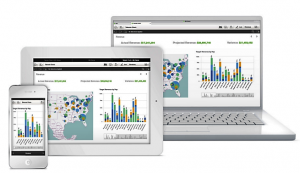 It’s no secret that data is one of today’s most valuable business assets and organizations possess the ability to collect a seemingly infinite amount of it. The challenge, however, is that much of that information remains underutilized because most organizations don’t have the resources to process (let alone understand) it all.
It’s no secret that data is one of today’s most valuable business assets and organizations possess the ability to collect a seemingly infinite amount of it. The challenge, however, is that much of that information remains underutilized because most organizations don’t have the resources to process (let alone understand) it all.
Data visualization presents one solution to the challenge of making sense of all this information. Utilizing the principles of graphic design, marketing and IT leadership, for instance, organizations can deliver innovative ways of representing data to identify previously undetectable patterns in information or effectively communicate key trends to stakeholders. Data visualization tools and techniques offer executives, and others new approaches to dramatically improve their ability to grasp information hiding in their data.
Benefits of Data Visualization in the Organization
Below are some of the benefits that data visualization offers to decision makers and their organizations:
Making better, more informed business decisions
Data visualization enables users to collect vast amounts of information with respect to operational and business conditions. It permits decision makers to visualize connections between multi-dimensional data sets and affords new ways to interpret data. Organizations that use visual data discovery are more likely to uncover the information they require, and thus more likely to increase their overall productivity.
Finding connections among data sets
One of the key benefits of data visualization is how it enables users to more effectively see connections as they are occurring between operating conditions and business performance. In today’s highly competitive business environment, finding these correlations among the data has never been more crucial.
Identifying and acting on emerging trends
The volume of data that organizations are able to collect about customers and market conditions can provide business leaders with insights into new revenue and business opportunities, assuming they can identify the opportunities in the mountain of data. With data visualization, decision makers are able to understand shifts in customer behaviors and market conditions across multiple data sets much more quickly.
Manipulating and interacting directly with data
One of the greatest strengths of data visualization is how it brings actionable insights to the surface. Unlike one-dimensional tables and charts that can only be viewed, data visualization tools enable users to actively interact with data.
How to get started with Data Visualization
Defining the organization’s objectives
Like so many things in business, compelling data visualizations start with clearly defined objectives or goals — a view sometimes lost on technical leaders who, drawn to the graphical possibilities, may sacrifice impact for aesthetics.
Defining objectives can be challenging, particularly because there can be many different ways to depict any one pattern. Data analysts and visualization experts will often go back and forth, making trade-offs to identify the most suitable and effective approach for the situation.
Data visualization has become an integral part of business intelligence systems, making reports more informative and visually pleasing and aiding to fuel the development of user-friendly executive dashboards and mobile BI applications. But successful visualization efforts hinge partly on choosing the right tools for the job at hand — and that necessitates more than a quick look at some colorful graphics.
Standalone data visualization software or visualization tools?
One of the most fundamental issues to consider is whether to buy standalone data visualization software or go with visualization tools that are offered as part of broader BI platforms. To answer that question, an evaluation and selection team will first need to acquire a good understanding of the kinds of data visualizations that business users want to see and the level of visualization functionality that is required.
Selecting the right vendor
With most organizations already having BI (Business Intelligence) and analytics tools in place, a related consideration is whether to remain with an existing vendor or look for a new one. There can be apparent advantages to dealing with one vendor, or a limited number of them. But those advantages might not be so great if a current vendor obtained its visualization software and has not fully integrated the technology into its primary BI platform.
IT or BI managers should be involved in the process of evaluating and selecting data visualization tools, mostly to make sure that back-end BI systems can handle the visualization load. It’s also essential that a spectrum of business users should have a say as well, from the executives and operational workers who will base business decisions on visualized data to the power-user analysts who are likely to handle the job of crafting visualizations.
The Litcom Approach
Litcom is an official Qlik Partner. We help organizations turn a vast array of data into valuable information that drives decision-making in a corporation. Our solutions ensure that all data has clear definitions and a fully understandable presentation to users.
Data Visualization – Seeing is Believing
Litcom is offering a risk-free, no-cost opportunity for you to experience the power and benefit of Business Analytics and Data Visualization.
Litcom’s ‘See Is Believing’ (SIB) allows yo

After the completion of the SIB application you will have an evaluation period during which IT and business users can test and experience the power of Data Visualization first hand.
I am interested in a complimentary SIB
Stay Connected
265 Rimrock Rd., Suite 202
Toronto, Ontario M3J 3C6
phone: 905 763 8900
fax: 905 763 8233
email: [email protected]
Recent Posts
- Digital Strategy
- Data Visualization – Why every organization needs a DV plan and how to get started
- Hiring Project Managers and Business Analysts – Why finding good ones is so challenging and how to acquire the right fit for your organization
